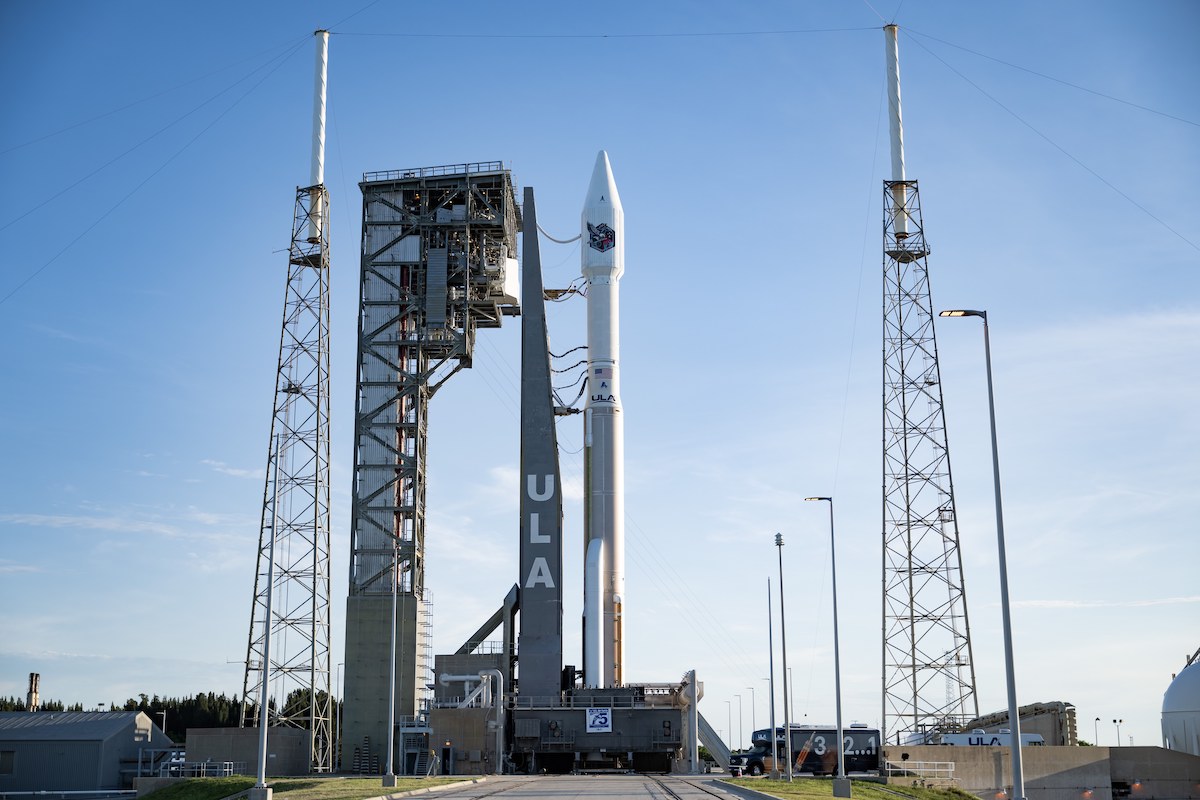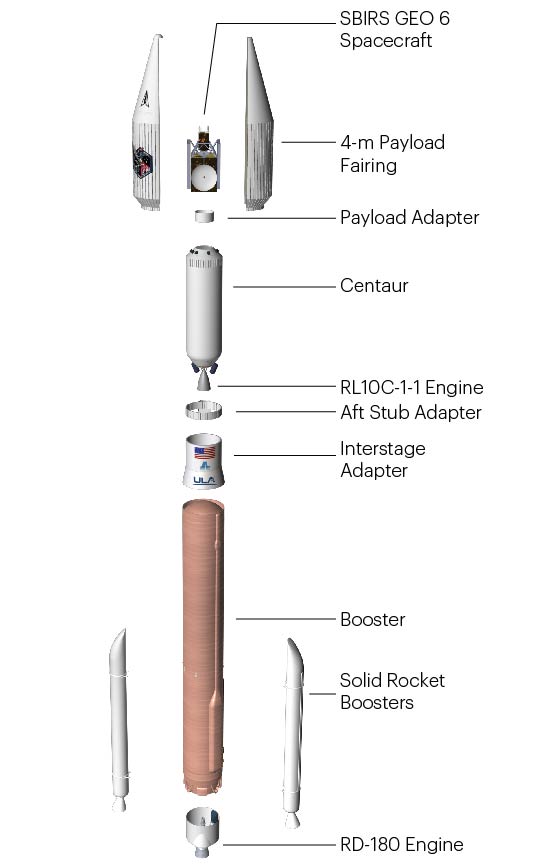Live coverage of the countdown and launch of a United Launch Alliance Atlas 5 rocket from pad 41 at Cape Canaveral Space Force Station in Florida. The mission will launch the U.S. Space Force’s SBIRS GEO 6 missile warning satellite toward geosynchronous orbit. Text updates will appear automatically below. Follow us on Twitter.
SFN Live
United Launch Alliance’s fifth mission of the year is set for liftoff from Cape Canaveral during during a 40-minute launch window opening at 6:29 a.m. EDT (1029 GMT). An Atlas 5 rocket will launch on a $1.2 billion mission with a U.S. Space Force missile warning satellite.
The countdown is set to begin at 11:09 p.m. EDT Wednesday (0309 GMT Thursday) with the power-up of the rocket, checks of the launcher’s guidance system, and preparations to start loading cryogenic propellants into the Atlas 5.
The mission will be the fifth Atlas 5 flight of the year, and the 95th launch of an Atlas 5 rocket overall. It is one of 22 Atlas 5s remaining in ULA’s inventory before the rocket is retired. ULA, a 50-50 joint venture between Boeing and Lockheed Martin, is developing the next-generation Vulcan Centaur rocket to replace the Atlas and Delta rocket families.
The payload for Thursday’s mission is SBIRS GEO 6, the final satellite in the Space Force’s Space Based Infrared System. The SBIRS satellites carry infrared sensors to detect heat plumes from missile launches, giving warning of a potential attack to U.S. military forces and government leaders.
Built by Lockheed Martin, the SBIRS GEO 6 satellite weighs about 10,700 pounds (4,850 kilograms) fully fueled for launch.
The first SBIRS payload in an elliptical orbit launched in 2006, and the military launched the first SBIRS satellite into geosynchronous orbit in 2011. The SBIRS program replaced the military’s Defense Support Program, a series of 23 missile warning satellites launched between 1970 and 2007.
One of the infrared cameras on each SBIRS GEO satellite scans across the spacecraft’s coverage area in a U-shaped pattern. With a fleet positioned around the world, the SBIRS satellites and the remaining long-lived DSP satellites provide global coverage to detect missile launches. Another infrared sensor can be aimed at specific regions of interest.
“There’s a staring sensor that can be pointed at and stare at a fixed point,” said Michael Corriea, Lockheed Martin’s vice president overseeing the SBIRS program. “So for example, you can task it to look over China because there was something you maybe wanted to look at in a particular area, or North Korea.

After a few hours of early countdown preparations, ULA’s launch team at Cape Canaveral’s Atlas Spaceflight Operations Center will give the “go” for the start of cryogenic tanking of the Atlas 5 around 4:30 a.m. EDT (0830 GMT).
Nearly 66,000 gallons of liquid hydrogen and liquid oxygen will be loaded into the two-stage Atlas 5 rocket. The Centaur upper stage’s Aerojet Rocketdyne RL10 engine burns the hydrogen and oxygen propellant mix, and the Atlas first stage consumes liquid oxygen with 25,000 gallons room-temperature kerosene fuel, which was loaded into the rocket Tuesday, soon after ULA ground crews rolled the Atlas 5 the launch pad from the nearby Vertical Integration Facility.
Two built-in holds will occur in the countdown, one at T-minus 2 hours and another at T-minus 4 minutes, before the final four-minute terminal countdown sequence to prepare the Atlas 5 rocket liftoff.
The rocket’s propellant tanks will be pressurized, and the RD-180 engine is set to ignite at T-minus 2.7 seconds. After building up thrust on the main engine, the Atlas 5 sent the command to light two Northrop Grumman strap-on solid rocket boosters to power the launcher off pad 41 with 1.6 million pounds of thrust.
The version of the Atlas 5 ready for launch on the SBIRS GEOE 6 mission is known as the “421” configuration, with the first number denoting the size of the payload fairing, the second number representing the number of solid rocket boosters, and the third digit the number of engines on the Centaur stage.
The SBIRS GEO 6 mission will mark the ninth and final flight of an Atlas 5 rocket in the 421 vehicle configuration, and the final launch from Cape Canaveral of an Atlas 5 rocket with the Atlas program’s classic conical 4-meter (13-foot) diameter nose cone. One more Atlas 5 with a 4-meter fairing is scheduled to launch later this year from California, while the rest will fly with the larger, more bulbous 5-meter payload fairing.
After liftoff, the 194-foot-tall (59-meter) Atlas 5 rocket, designated AV-097 for this mission, will head east from Cape Canaveral to target the mission’s elliptical, or oval-shaped, geosynchronous transfer orbit
The Atlas 5 will surpassed the speed of sound in 49 seconds, then shed its spent strap-on boosters at T+plus 2 minutes, 13 seconds.
The first stage’s RD-180 engine will fire until T+plus 4 minutes, 12 seconds. Six seconds later, the first stage will separate from the Atlas 5’s Centaur upper stage, which will ignite its RL10 engine at T+plus 4 minutes, 28 seconds. The clamshell-like payload shroud on top of the Atlas 5 will jettison at T+plus 4 minutes, 36 seconds, once the rocket is flying above the thick lower layers of the atmosphere.
Three RL10 engine burns are planned before the Atlas 5 releases the SBIRS GEO 6 satellite at T+plus 3 hours, 1 minute.
The Atlas 5’s guidance computer will aim to release the spacecraft in an orbit ranging in altitude between 3,242 miles (5,218 kilometers) and 21,956 miles (35,335 kilometers), with an inclination angle of 17.63 degrees to the equator.

The SBIRS GEO 6 spacecraft will use an on-board propulsion system to steer itself to a circular geosynchronous orbit that is continuously at an altitude of nearly 22,300 miles over the equator. In that orbit, the satellite’s velocity will be fixed with the rate of Earth’s rotation, giving the craft’s infrared early warning sensors a constant view of the same part of the planet.
The satellite will also extend power-generating polar panels and light shades to begin fine-tuning the performance of is heat-seeking sensors.
SBIRS GEO 6 should be ready to enter operational service in early 2023, according to Space Force officials. The satellite is designed for a 12-year mission. Read our mission preview story for more details on SBIRS GEO 6.
ROCKET: Atlas 5 (AV-097)
MISSION: SBIRS GEO 6
PAYLOAD: SBIRS GEO 6 missile warning satellite
CUSTOMER: U.S. Space Force
LAUNCH SITE: SLC-41, Cape Canaveral Space Force Station, Florida
LAUNCH DATE: Aug. 4, 2022
LAUNCH WINDOW: 6:29-7:09 a.m. EDT (1029-1109 GMT)
WEATHER FORECAST: 70% chance of acceptable weather
BOOSTER RECOVERY: None
LAUNCH AZIMUTH: East
TARGET ORBIT: Perigee of 3,242 miles (5,218 kilometers); Apogee of 21,956 miles (35,335 kilometers); Inclination angle of 17.63 degrees to the equator.
LAUNCH TIMELINE:
- T-00:00:02.7: RD-180 ignition
- T+00:00:01.1: Liftoff
- T+00:00:06.0: Begin pitch/yaw maneuver
- T+00:00:48.9: Mach 1
- T+00:00:52.5: Maximum aerodynamic pressure (Max-Q)
- T+00:02:13.3: Solid rocket booster jettison
- T+00:04:12.4: Atlas booster engine cutoff (BECO)
- T+00:04:18.4: Atlas/Centaur stage separation
- T+00:04:28.4: Centaur first main engine start (MES-1)
- T+00:04:36.4: Payload fairing jettison
- T+00:12:55.4: Centaur first main engine cutoff (MECO-1)
- T+00:22:54.6: Centaur second main engine start (MES-2)
- T+00:27:38.8: Centaur second main engine cutoff (MECO-2)
- T+02:57:40.5: Centaur third main engine start (MES-3)
- T+02:58:38.4: Centaur third main engine cutoff (MECO-3)
- T+03:01:27.4: SBIRS GEO 6 spacecraft separation
MISSION STATS:
- 677th launch for Atlas program since 1957
- 378th Atlas launch from Cape Canaveral
- 266th mission of a Centaur upper stage
- 243rd use of Centaur by an Atlas rocket
- 513th production RL10 engine to be launched
- 2nd RL10C-1-1 engine launched
- 101st flight of an RD-180 main engine
- 95th launch of an Atlas 5 since 2002
- 37th U.S. Air Force/Space Force use of an Atlas 5
- 18th-19th GEM-63 solid rocket boosters flown
- 79th launch of an Atlas 5 from Cape Canaveral
- 5th Atlas 5 launch of 2022
- 137th Evolved Expendable Launch Vehicle flight
- 152nd United Launch Alliance flight overall
- 87th Atlas 5 under United Launch Alliance
- 110th United Launch Alliance flight from Cape Canaveral
- 6th launch of a SBIRS GEO satellite
- 57th 400-series flight of the Atlas 5
- 9th Atlas 5 to fly in the 421 configuration
- 106th launch from Complex 41
- 79th Atlas 5 to use Complex 41
- 33rd orbital launch overall from Cape Canaveral in 2022
from Spaceflight Now https://ift.tt/yx6590G
via World Space Info







0 comments:
Post a Comment